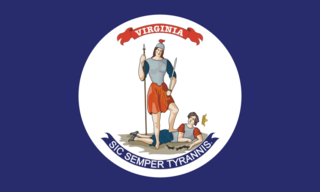The Michigan Brigade, sometimes called the Wolverines, the Michigan Cavalry Brigade or Custer's Brigade, was a brigade of cavalry in the volunteer Union Army during the latter half of the American Civil War. Composed primarily of the 1st Michigan Cavalry, 5th Michigan Cavalry, 6th Michigan Cavalry and 7th Michigan Cavalry, the Michigan Brigade fought in every major campaign of the Army of the Potomac from the Battle of Gettysburg in July 1863 to the Confederate surrender at Appomattox Court House in April 1865.
The 1st Regiment, Rhode Island Cavalry was a cavalry regiment that participated in the American Civil War. They were badly routed at the Battle of Middleburg, a blemish on an otherwise competent combat record.
The 8th Regiment, Ohio Cavalry was a regiment of cavalry raised by the state of Ohio for service during the American Civil War. It served in the Eastern Theater, primarily in West Virginia and then in the Shenandoah Valley region of Virginia.
The 8th Ohio Volunteer Infantry was an infantry regiment in the Union Army during the American Civil War. It served in the Eastern Theater in a number of campaigns and battles, but perhaps is most noted for its actions in helping repulse Pickett's Charge during the Battle of Gettysburg.
The 139th Pennsylvania was an infantry regiment in the Union Army during the American Civil War.
The 4th Regiment, Ohio Volunteer Infantry was an infantry regiment in the Union Army during the American Civil War. It served in the Eastern Theater in a number of campaigns and battles, but perhaps is most noted for its actions in helping secure Cemetery Hill during the Battle of Gettysburg.
The 7th West Virginia Volunteer Infantry Regiment was an infantry regiment that served in the Union Army during the American Civil War. For much of the war, it was a part of the famed "Gibraltar Brigade" in the Army of the Potomac. It was famed primarily for two major actions, a determined charge on the Sunken Road at Antietam and a late evening counterattack on East Cemetery Hill at Gettysburg that helped push back an attack by the Louisiana Tigers.
The 5th Wisconsin was an infantry regiment that served in the Union Army during the American Civil War.
The 74th Pennsylvania Volunteer Infantry was an infantry regiment which served in the Union Army during the American Civil War. It was one of many all-German regiments in the army, most notably in the XI Corps of the Army of the Potomac. Its combat record was marred by the perceived poor performance of the entire corps at Chancellorsville and Gettysburg, when parts of the corps routed during Confederate attacks.

The 7th Ohio Volunteer Infantry was an infantry regiment formed in northeastern Ohio for service in the Union Army during the American Civil War. It served in the Eastern Theater in a number of campaigns and battles with the Army of Virginia and the Army of the Potomac, and was then transferred to the Western Theater, where it joined the Army of the Cumberland besieged at Chattanooga. It is of the 7th regiment that a war historian wrote, "All in all, considering the number of its battles, its marches, its losses, its conduct in action, it may be safely said that not a single regiment in the United States gained more lasting honor or deserved better of its country than the Seventh Ohio Volunteer Infantry.”

The 22nd Regiment Massachusetts Volunteer Infantry was an infantry regiment in the Union army during the American Civil War. The 22nd Massachusetts was organized by Senator Henry Wilson and was therefore known as "Henry Wilson's Regiment." It was formed in Boston, Massachusetts, and established on September 28, 1861, for a term of three years.

The 5th Regiment Michigan Volunteer Cavalry was a cavalry regiment that served in the Union Army during the American Civil War. It was a part of the famed Michigan Brigade, commanded for a time by Brigadier General George Armstrong Custer.
The 3rd Regiment, Ohio Volunteer Infantry was an infantry regiment in the Union Army during the American Civil War. It served in several important campaigns in the Western Theater in Kentucky, Tennessee, and Alabama.
The 5th Regiment, Ohio Volunteer Infantry was an infantry regiment from southwestern Ohio that served in the Union Army during the American Civil War, serving in both the Eastern and Western Theaters in a series of campaigns and battles.
The 5th Regiment, Ohio Cavalry was a regiment of Union cavalry raised in seven counties in southwestern Ohio for service during the American Civil War. It primarily served in the Western Theater in several major campaigns of the Army of the Tennessee.

The 13th Virginia Volunteer Cavalry Regiment was a cavalry regiment raised in Virginia for service in the Confederate States Army during the American Civil War. It fought mostly with the Army of Northern Virginia.

Ira Wallace Claflin was a United States Army West Point regular officer who took command of the 6th US Cavalry during the critical days of July 1863 during the Gettysburg Campaign. He was an instructor of Union cavalry tactics for West Virginia and later taught at West Point.
Alexander C. Elliott was a United States soldier who fought with the Union Army during the American Civil War as a sergeant with Company A of the 1st Pennsylvania Cavalry. He received his nation's highest award for valor, the U.S. Medal of Honor, for his actions at Paines Crossroads, Virginia on April 5, 1865. That award was conferred on May 3, 1865.
The 4th New Jersey Volunteer Infantry was an infantry regiment in the Union Army during the American Civil War.
The 1st Regiment Delaware Volunteer Cavalry was a cavalry regiment of the Union Army in the American Civil War.





